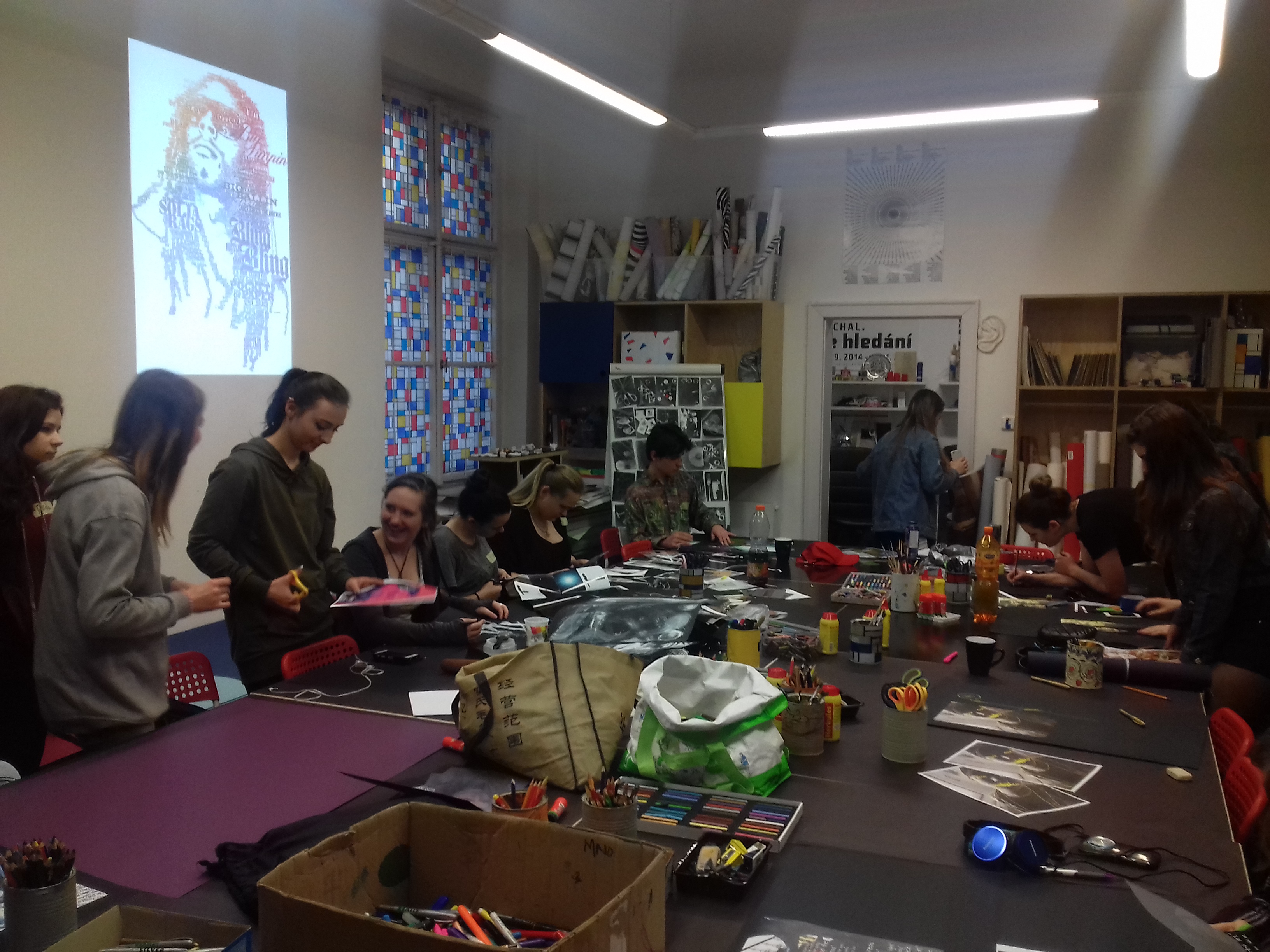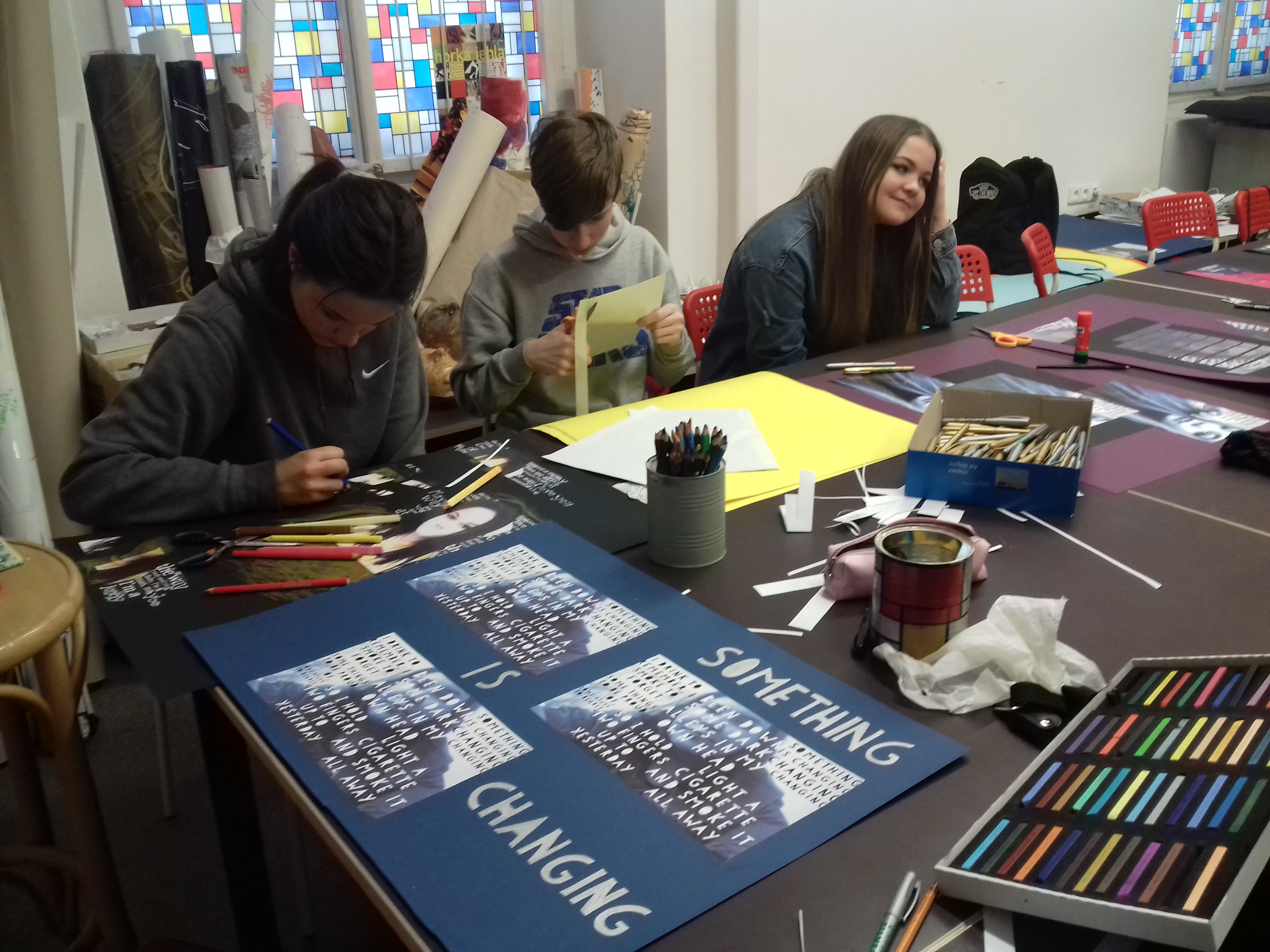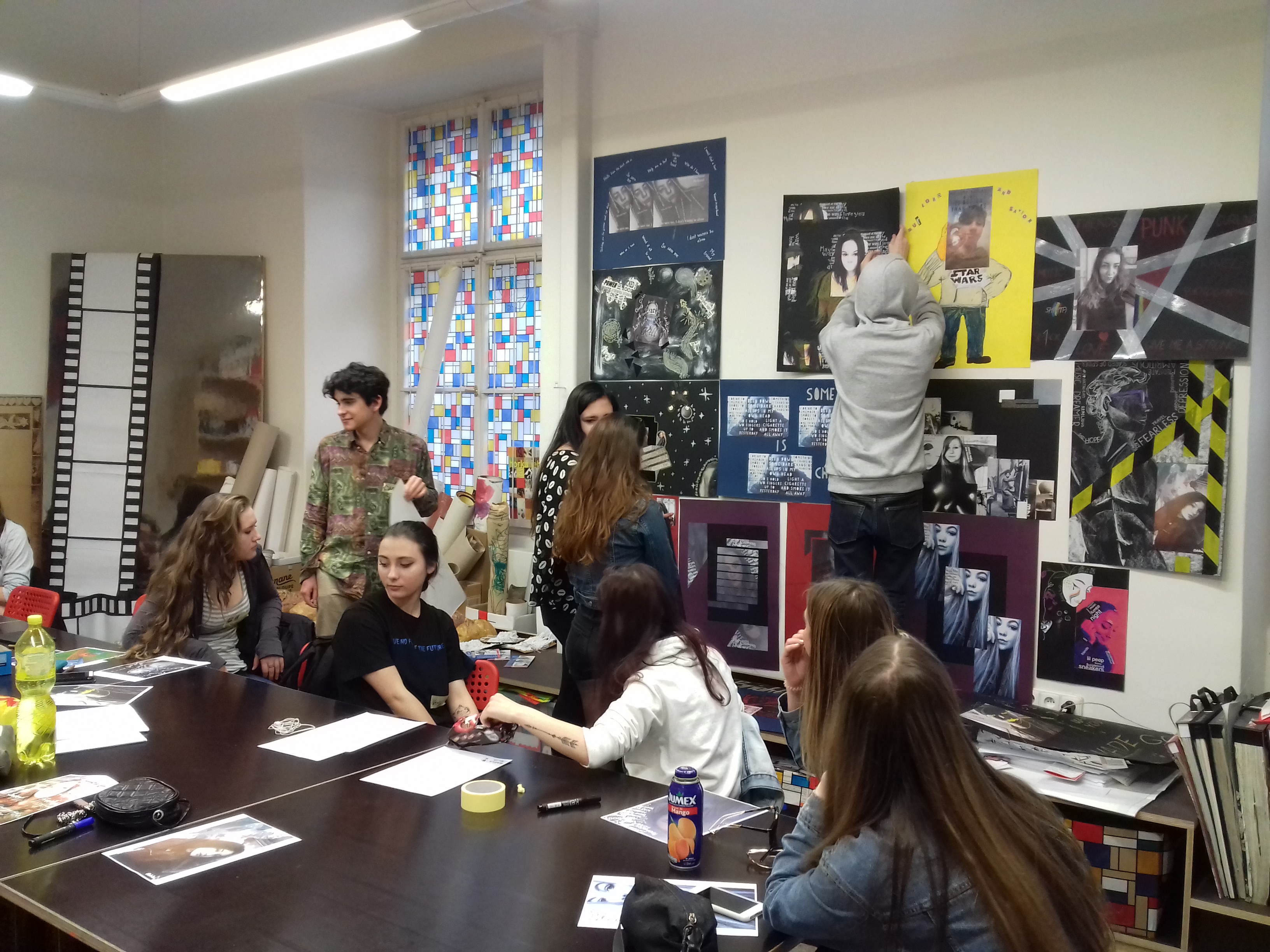Self-portrait and identity
Organising institution:
European Development Agency (EUDA)
Country:
Czech Republic
Age:
16
Key question:
How can we express and portray our own unique soul, mind and various identity by a combination of the photo with text and by using different art styles to demonstrate the diversity of society?
Objectives:
- to understand terms of: identity, diversity, uniqueness, society, tolerance, coexistence;
- to examine relations between picture (photo) and text (words, letters);
- to use different current ICT tools to find out possibilities to combine picture (photo) and text (words, letters);
- to express identity not only by photo (formal, visual level) but also by text (content, meaning level);
- to teach to be tolerant (thanks to seeing different styles, ideas, minds, values, characters);
- to demonstrate, how to use new media (mobile apps) by the effective and useful way for art education;
- to develop visual, literary, media and digital literacy, to develop communication;
- to inform about positives and negatives (difficulties) of new media and social networks.
Time:
2 x 3 hrs / 1 x 6 hrs
Software and apps to be used:
Mobile phone, computer, colorful printer, data projector, various applications (Photo Director – Photo Editor, Photo Lab Picture Editor, Photo Lab – Shattering Effect and so on).
Brief presentation:
This digital atelier is concentrated on self-reflection in the context of perception of whole society, the main topic is an expression of identity by various art styles and to find out, that every person has own style, mind, soul, character, belief, values and so on... At first, pupils and students make photo self-portrait by using mobile phone, then they transform it by various applications in mobile (changes of colors, shapes and so on), then they prepare texts (favorite quotes, text fragments from books, from music, their own sentences, which illustrate their minds and character), then they connect photo with text by mobile apps by creative way, this artwork is printed (size A4, 1-3 pieces), then it's stuck down on big colorful paper (size A2) and transformed by classical creative ways (painting, drawing, collage, spatial art and so on...). At the end of this digital atelier, students realize their collective exhibition of final artifacts for comparison various art styles, minds, ideas, ways, values and so on – and also for a finding of similarity and differences of some artifacts. Thanks to this diversity of styles and ways students can find out, that everybody from them is a unique personality. It teaches them to be tolerant of diversity in society.
Topics covered:
- ICT.
- Development of literary+visual+medial+digital literacy, creativity, self-reflection, communication, society, integration, creativity, imagination.
- Art pedagogy, literature, language, psychology, sociology.
Civic engagement:
Students have been able to make public engagement project in this way... For them (as a new generation) it´s a very natural and attractive way, how to realize something important, useful and helpful and how to make public engagement for society. These topics – self-portrait and identity are very useful. It teaches students to be tolerant, to see, that everybody has own different ideas, values, character, belief, unique soul and valuable identity. They can find out, that it is all about tolerance, diversity, uniqueness and about free and peaceful coexistence in society. It can be used for example for natural, interesting and attractive integration of new children, pupils or students in the class – for example migrants. Art is universal and international language, so for people from a foreign country, it´s a nice, pleasant and helpful way, how to communicate by art, when they don´t know our language. By this workshop, they can also present themselves and tell to other people something about them. It can be also used as a helpful instrument for helping disadvantaged or ill or lonely people to share interesting topics about identity with some community. So this DA can be very profitable, salutary and beneficial to society. Many workshops in our Prague City Gallery include these aspects of civic and social engagement. Educational department of Prague City Gallery realizes many special workshops and events for disadvantaged visitors. This DA can have a positive impact. For example, it can motivate students to be courageous, brave and fearless to express their originality, their own inner world, and their differentnesses. Partly it can eliminate a cybernetic bullying in successful cases. It can teach them to be tolerant of each other because everybody has big value and right for freedom and differentnesses. This is one of the most important missions and functions of this DA.
Preparation of space for the Atelier:
Space for this workshop needs this: enough big tables (one big table for the whole group is ideal), enough chairs for everybody, a place for projection from data projector – projection of inspirations for students, color printer, whiteboards with papers.
Materials needed:
ICT tools (mobile phone, data projector, colorful printer), scissors, glues, glue tapes, pastels, colors, colorful papers (A2 or A3), stickers, cut up letters, brushes, sprays and so on…
Main inspirations taken from personal research:
This topic is connected to two main areas: fine art and literature+linguistics, but it can be connected with more areas …
Sources of inspiration:
- fine arts: Lettrism, graphic design, street art, typography, sculptures from letters… (letters as medium, instrument, and tool for art creations);
- literature and linguistics: visual poetry, experimental poetry, concrete poetry… (letters, words, sentences, and texts as a channel, medium or level for meaning, content);
- film – for example Matrix, Blade Runner, Space Odyssey (sci-fi, fantasy and virtual reality as space full of many pieces of information).
Mass media and social media connections:
As it was said in the previous task: film – for example Matrix, Blade Runner, Space Odyssey (sci-fi, fantasy and virtual reality as space full of many information) – an expression of information (words, numbers, pictures, photos) by virtual reality (010101…). This digital atelier is partly similar to a presentation on social networks (connection of photo and text). Short sentences can remind texts in newspapers, in adverts, in street art, in graphic design or titles in television and films…
How do you plan to give voice to students to present or show their personal skills and knowledge?
In this Digital Atelier, I provide big space for students to present their personal skills and knowledge by artistic activity – by making own artifacts, by their considering about connections of picture and text and also by a discussion about their ideas during the final collective exhibition about their ideas…

How do you collect information as the starting point of a Digital Atelier?
How do I collect all information? During digital atelier students fill up several questionnaires, during the whole realization, there is a constant discussion with the biggest one at the end, I make photo and video documentation intensively during the whole workshop, I work continuously on case interpretations…
Introducing students to the key question - the research begings:
How can we express and portray our own unique soul, mind and various identity by a combination of a photo with text and by using different art styles to demonstrate the diversity of society?
Experimental phase
- Action that unfolds the practical activity to clarify the question: How can we make our self-portrait by an experimental photo? After the presentation of inspirations and examples of lettristic portraits for students using a data projector, we discuss identity and portraits and then students try to start with making their own self-portraits and transform them in apps in mobile phones (colors, shapes and so on…).
- Active work of the students: Making photos of themselves (self-portraits), a transformation of photos in mobile applications.
- Presentation of findings and results (visualisation of information): After this phase students have the photo of their own portrait in their mobile device and they have it prepared for the second phase… It´s possible to present it through a data projector to all students.

Project/design phase - part 1
- Second action that unfolds the practical activity: How we can express our ideas and minds through text? During this phase, students prepare their texts for their portrait and then they use the application in mobile devices to put text into their photo and to connect it together in a creative way.
- Active work of the students: At first, students consider their texts (letters, words, favorite quotes, text fragments from books, music and so on) and they write them into a summary. Then they work on a mobile phone with special apps to connect their self-portrait with these texts.
- Presentation of findings and results (visualisation of information): After this phase students have their self-portrait in their mobile connected with their texts and covered by their letters, words, and sentences. It´s possible to present it through a data projector to all students again.
- Analysis of results: Students use many possibilities, how to join the text into their portraits. It´s possible to see many variations, interpretations, and ways, how can letter communicate with picture…
Project/design phase - part 2
- Third action that unfolds the practical activity: How can we go on with working on our self-portraits by combining our artifact from the mobile with the classical way of creation? During this phase, students print their artworks from mobile through the colorful printer. Then they stick down this artifact on paper and they try to finish it by the classical creative way.
- Active work of the students: Students stuck down printed self-portrait and go on with working on it with a classical creative way - painting, drawing, collage and so on.
- Presentation of findings and results (visualisation of information): After this phase students have real physical artifacts. Then it is presented during the final collective exhibition in the classroom for comparison of various art styles. It´s connected with discussion and evaluation.
- Analysis of results: It is possible to see the use of many art styles, in which self-portraits were created by students - lettristic style, expressive style, surrealistic style, geometric style, cubistic style, fauvistic style, literary style, street art, graphic style (as graphic design) and so on... There are many interpretations of the self-portraits. Criteria: in every artwork try to find out, if there is a stronger accent on the form (visual level) or accent on content (meaning level); in every artwork try to discover style, in which it was created - lettristic style, expressive style, surrealistic style, geometric style, cubistic style, fauvistic style, literary style, street art, graphic style (as graphic design) and so on...; to separate artworks into two groups: first g., where using working with ITC is dominant, the second g., where using of classical techniques is dominant; to classify artworks according to emotions, it means according to the fact, if they are more optimistic or pessimistic; to find out, which artworks are created in maximalist style and which is a minimalistic style; to compare parallel and contrasting artworks; to find similarity and differentness between some chosen artworks.
During the discussion and in final questionnaires students spoke about Digital atelier – which part was for the most interesting and why (they had different statements). They also tried to propose another new topic for a combination of picture and text (for example picture of a city full of information, virtual reality, expression of music, experimental poetry, nature, the world of biology and chemistry and so on...).
Approach to a new software or a new app:
During this DA I explain to students, how to use a model application – for example, Photo Director. I show them all the details and steps on the mobile phone and also through big projection by data projector. They can also try to find and download and use other similar applications. We also speak about mobiles, applications, digitalization of society, sharing information or about risks or dangers on social networks. It´s important to discuss and to speak together about rigorous, dangerousness and hazardousness of self-presentation on social networks. About the fact, that social networks are places for sharing interesting information and news, but at the same time also danger zone. It´s important to explain, that privacy is the biggest treasure. The self-portrait is a great topic for art, but we must be very careful to work with it on the Internet and social networks.
Links between the Digital Atelier and real life of the students:
This Digital Atelier can have a positive and straight impact for students. For example, it can motivate students to be courageous, brave and fearless to express their originality, their own inner world, and their differentness. It can teach them to be tolerant to each other because everybody has big value and right for freedom and differentness. It can also help disadvantaged or handicapped pupils or students for better integration into the class.

How do you plan to evaluate knowledge and skills?
The best way, how to evaluate it, is to use a special questionnaire several times during the DA. Another way is to hold a discussion continually with the biggest final discussion at the end to compare all artifacts together through collective exhibition and try to see diversity and try to find similarity and differences.
Conclusion:
This DA was very successful. We reached all the main aims (objectives). The expectations were more than met. It´s very useful for students and also for society (integration of foreign people, migrants or disadvantaged people). DA with topic „Self-portrait and identity“ provided many possibilities, how to realize and accomplish our main aims. During this DA there were shown, proved and demonstrated, that ICT (in this case mobile applications) can become an interesting art tool for experimental creations. It can be very useful, helpful and inspirational medium for art and education. Mobile application Photo Director and similar available apps became something as helper or assistant for students. It became also something as pencil, brush or fix, but the most as a typewriter. Students used apps here for the creation of experimental texts, letters, signs, codes, ciphers and so on and for connection of it with picture (photo) by very effective and easy way. Partly it´s a similar work as work in 50´s or 60´s when legendary artists (poets and painters) worked in style of Lettrism and experimental poetry (visual and concrete poetry)… or like in 70´s, 80´s and 90´s and nowadays, when artists work in the style of street art. In all these styles of art, especially in street art, the main topic is an expression of identity by texts and pictures. Identity as also one of the most frequented topics in contemporary art it´s more and more important nowadays. Importance of identity increases very quickly every day in many disciplines (art, psychology, sociology, politics, education and so on). In these difficult times, when children, pupils, and students have addiction on social networks, when they present every detail from their lives, when the internet is full of fake news, false identities and false „reality“, there it´s more than important to inform them about dangers of virtual reality, about the fact that privacy and also identity are ones of the biggest treasures in our lives. It´s also very important for pupils and students to find out, who they are; what are their values and aims; where are they going and why… And mainly also to find out, that everybody has his/her own identity with many differentnesses, that everybody is a unique person with rights of originality, uniqueness, and freedom. So it can empower their personality very well, they can become more tolerant and better persons. Using of ITC can be very useful and helpful to reach important aims. But it should be used in balanced and harmonious ways in cooperation with classical ways of creativity, learning, and thinking. It must also have HQ educational content. So, it´s not only about „how we do it by ITC“, but also „what is all about“ – it means, that choice of topic is one of the most important issues. It can be successfully realized by erudite teachers, which are flexible and open for new ways of teaching.
The publication was created as part of the project: APP YOUR SCHOOL.
This publication reflects the views only of the author, and the Commission cannot be held responsible for any use which may be made of the information contained therein.

